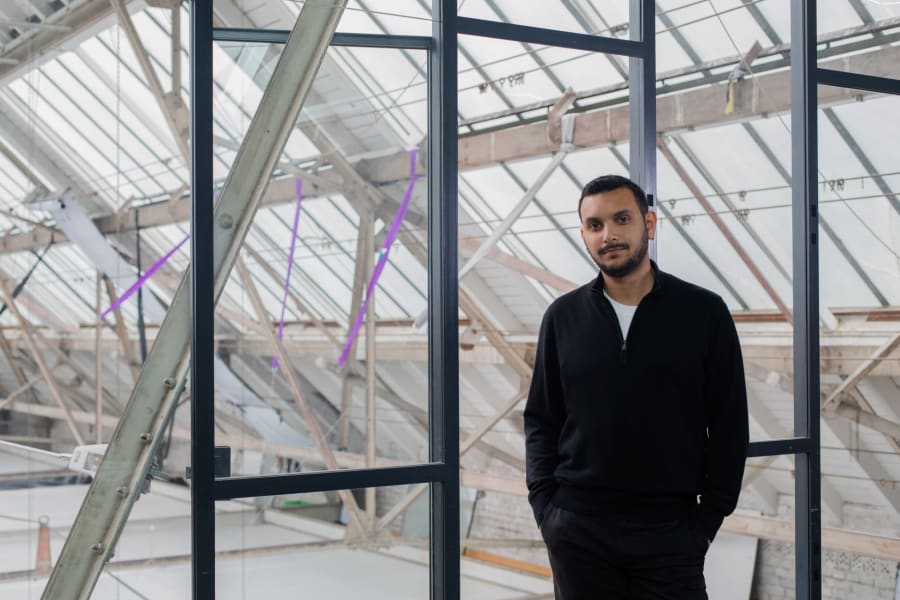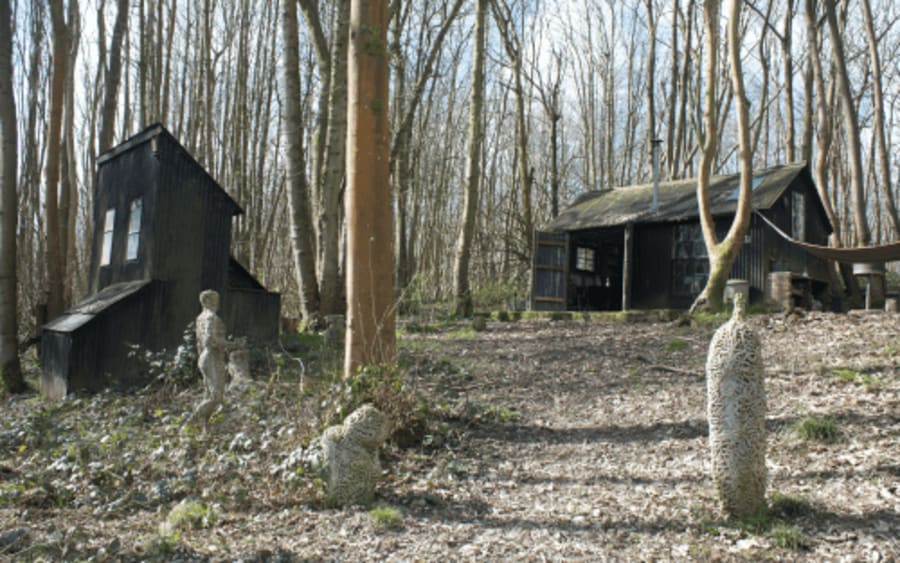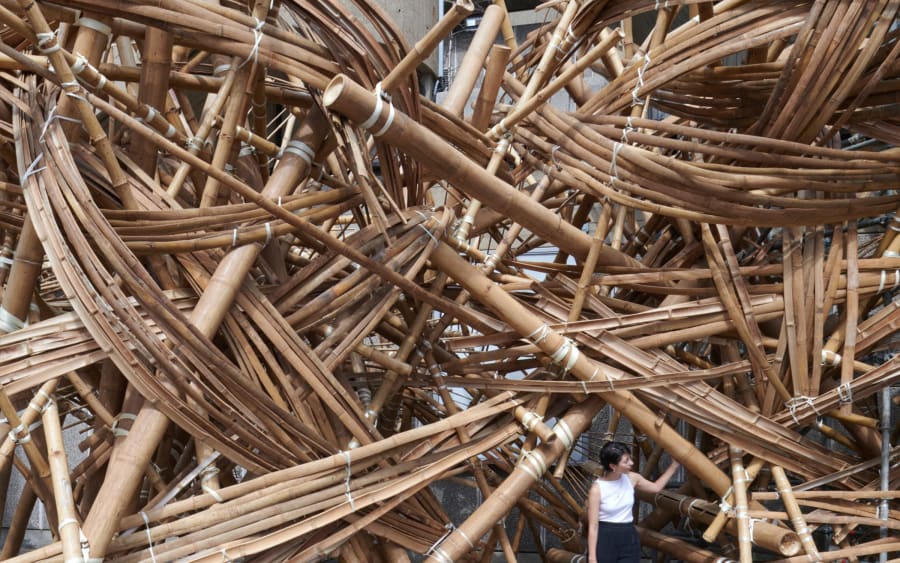Uriel Orlow has a nose for things hidden or overlooked. In his early projects, he tracked undocumented events that haunted far-flung locations from Armenia to Benin; more recently, he set his sights on the entangled geopolitics of plants. ‘We consider animals to have agency and power, plants are the backdrop, the lowest rung on the evolutionary ladder,’ he says. Yet the vegetal has played key roles in the forces that continue to define the human world, from the deployment of colonialism to climate change, as the Swiss artist’s films, social projects, drawings, sound works, photography, and publications make clear.
When we speak over the summer, Orlow is readying ‘Knowledge Is a Garden’, an exhibition of his earliest plant-focused works, alongside art by kindred spirits selected from the collection, which will open on September 28 at the Migros Museum in Zurich. He is also putting the finishing touches to a new film, Forest Futurism (2024), for a solo show at the Musée cantonal des Beaux-Arts, Lausanne, due to open a day earlier. Both projects endeavor to shift thinking around the significance of vegetation.
Orlow often describes plants as ‘witnesses’ and ‘actors.’ The implications of these terms, more often reserved for beings with active consciousness, is clear in Forest Futurism, a film produced in South Tyrol where Alpine flora has been creeping upwards for the past 150 years due to rising temperatures. The work was shot over the course of a year and Orlow’s cinematography captures an ancient forest of countless blooming greens and fossilized roots inscribed in rock, shifting light and seasons. We also see local children play and learn in hearty innocence. These youngsters’ narration provides the context, from the erupting volcanoes that shaped the landscape 280 million years ago, to the different pressures faced by humans and trees with climate change.
Forest Futurism brings together what Orlow sees as two fundamental impulses within his practice: the didactic – sharing the knowledge communally acquired in his collaborative projects – and the poetic. ‘I work in dialogue with people, and I want to include others in the conversation,’ he says. ‘It’s not about transmitting research though. It’s about embedding it within an experience, aesthetics, politics, and poetics.’
How complex this process can be is apparent at the Migros Museum in the artist’s earlier works exploring plants’ place in geopolitics. The exhibition’s centerpiece is the film trilogy Theatrum Botanicum (2016–17). Its three quite different experimental parts explore plant classification as an act of colonial violence, via historical and present-day conflicts of interest between South Africa’s traditional healers and a powerful globalized medical industry. Two of the trilogy’s films are scripted fictions. The Crown Against Mafavuke uses a court transcript to recreate a 1940 trial in which a local healer was accused of illegally using European plants in traditional medicine. Mafavuke’s Tribunal, meanwhile, sees the healer time-travel to the 21st century to discuss how the current pharmaceutical industry exploits Indigenous knowledge. In the documentary Muthi, the artist’s camera journeys into the world of traditional medicine, its foragers and healers, offsetting this with a perfectly ordered factory of commercial pharmaceuticals.
Orlow’s interest in plants was first triggered by a research trip to South Africa in 2014. He had been invited to create a project engaging with the archive of the African National Congress, the political party and movement advocating for the rights of Black South Africans and known for its fight against apartheid. But a chance visit to the Kirstenbosch National Botanical Garden set him on a different path.
‘Botanical gardens are often colonial archives, with plants from all over the world,’ he explains. ‘The whole South African colonial project began with the Dutch East India Company’s garden, created to replenish ships on the route to India. Kirstenbosch was different: it was full of beautiful endemic plants. Yet I noticed that all the labels were in Latin and English. This really struck me: 25 years after the end of apartheid in a country that has 11 official languages, of which English is one, but Latin isn’t, why only these two? There’s an epistemic violence in that, which goes back to the first Europeans arriving, exploring, naming, classifying the natural world they found and disregarding existing local knowledge.’
Typically, Orlow is an outsider to the places where he makes work, and he has developed a particular methodology. ‘It’s important for me that I’m invited, there’s a reason why I’m there, and I’m not imposing myself,’ he says. ‘I try to be humble, to listen, to discover but also understand the limits of understanding. I’m careful not to reproduce extractive mechanisms. I spend a lot of time in a place and let relationships build. Projects don’t happen in a vacuum, there’s a network of local support.’
His body of ecologically minded work has put Orlow at the forefront of a new wave of artists turning to nature in the shadow of the climate emergency. He points out though that he does not define himself as ‘a plant artist,’ something his curation of other artists’ works from the Migros collection will reinforce. ‘I wasn’t interested in creating a plant retrospective as such,’ he says. ‘It’s an opportunity to situate the work outside of botanical thinking and in a wider discourse about suppressed knowledge.’ The works include Canadian collective General Idea’s investigations into the concealment of medical information that furthered the AIDS crisis, and the German artist Maria Eichhorn’s explorations of censorship.
One particularly pertinent inclusion is Susan Hiller’s work, Lost and Found (2016), a recording of dying languages – and not just because it chimes with Orlow’s research into Indigenous plant names. Hiller was his art school examiner as an undergraduate and an early influence who later became a friend. ‘She wasn’t bound to a subject but always wanted to know things and share wonder and curiosity, whether it was the dark history of German street signs or about life after death experiences,’ he recalls.
This imaginatively roving, open-ended approach to research-based projects has underpinned Orlow’s work since he first impressed Hiller with his undergraduate film, 1942 (Poznan) (2006), shot at a Polish swimming pool converted from a synagogue by the Nazis. He says, however, that a significant creative breakthrough came the following year in 2007, when he made a clear decision to resist being labelled as a ‘holocaust artist’ or anything else. ‘Identity politics was becoming more present, and while it’s of course right to have other voices and for artists to tell their own stories, it also created an expectation to perform your identity,’ he reflects. ‘I wanted to complicate things.’
Orlow went on to create a series of works about the need for restitution of the Benin Bronzes, looted by the British in 1897 and shown throughout global museums. ‘It wasn’t my ancestors who had looted or been stolen from, but it still seemed an important question for me as someone living in London, having access to the British Museum,’ he says. ‘Questions of responsibility concern all of us.’
‘Uriel Orlow. Forest Futurism’
Musée cantonal des Beaux-Arts, Lausanne
September 27, 2024 – January 5, 2025
‘Knowledge Is a Garden’
Migros Museum für Gegenwartskunst, Zurich
September 28, 2024 – January 19, 2025
Uriel Orlow is represented by mor Charpentier (Paris, Bogotá) and Laveronica arte contemporanea (Modica).
Skye Sherwin is an art writer based in Rochester, UK. She contributes regularly to The Guardian and numerous art publications.
Caption for header image: Uriel Orlow, Photo: Florian Spring, © Bundesamt für Kultur.
Published on September 24, 2024.


